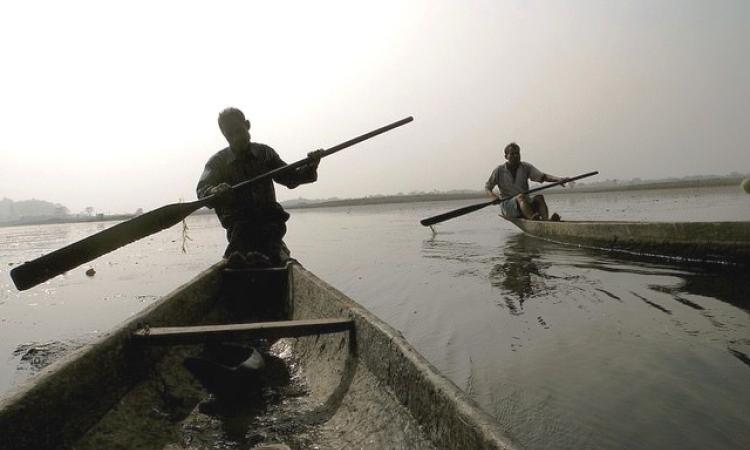
Dhemaji is one of the most flood-affected districts in Assam. Although the majority of its population depends on agriculture and sericulture, fishing and driftwood businesses are also practised on a smaller scale. People of Dhemaji are intimately associated with fish culture and capture for their livelihoods.
High frequency of floods and its effect on livelihoods
The paper titled 'Indigenous technical knowledge associated with disaster management and fisheries related activities in the highest flood affected district (Dhemaji) of Assam, India' published in the Indian Journal of Traditional Knowledge, informs that the entire population is concentrated on the river banks, and a number of drainage systems originating from the hills of Arunachal Pradesh flow through this narrow valley ending at the Brahmaputra.
Floods--of two types--are a frequent phenomenon here. One is due to the water from the rains and the runoff from the surrounding areas that start accumulating in low lying areas by May, June and submerge the areas until October/November. The other is when the water from the overflowing rivers and rains enters the fields and causes damage to lives, property, crops, roads and houses, while water logging creates a number of health problems and also impacts livelihoods.
Coping mechanisms among local fisherfolk
Most of the current efforts by the government to cope with floods focus on temporary relief measures. However, locals are known to have developed their own location-specific ways over the centuries. In recent times, the the importance of understanding indigenous traditional knowledge of communities in predicting and managing natural disasters has resurfaced. However, there continues to be a lack of information on this knowledge and techniques associated with flood related activities including early warning and weather prediction.
This paper presents the findings of a study that aimed at collecting and compiling indigenous technical knowledge of fisher households from three blocks of Dhemji district. 110 fisherfolk from 16 villages in these blocks were interviewed to get information on their traditional knowledge regarding detection and coping mechanisms for floods in the area.
Findings of the study:
The fisherfolk had a number of indicators that were helpful in early prediction of rains and floods such as observations based on:
- changes in animal behaviours such as cattle, insects, birds; and
- changes in celestial bodies, nature and meteorology such as position of moon, clouds, flowering of plants, days of rainfall and changes in rainfall patterns.
The villagers believed that due to an earthquake in the 1950s and the big dam construction in Arunachal Pradesh, a large number of big stones and boulders which acted as speed brakers for the currents of the Brahmaputra were broken or dislodged. This has now resulted in floods bringing in more sand than silt. They also believed that:
- the construction of river embankments without any scientific knowledge of the hydrodynamics of river water had been creating major problems; and
- the construction of roads without providing sufficient number of culverts increased the speed of the water currents which resulted in the destruction of agricultural fields and fish ponds.
The fisherfolk used traditional knowledge and skills to construct and protect ponds that provided drinking water during the winter. They constructed ponds in low lying areas with minimum excavation and tall embankments. This reduced the construction cost, protected them from inundation and ensured water retention in the winter season. Seepage was a big problem in districts where sand was deposited on the soils during floods. Raw cow dung mixed with water was layered at the bottom of the pond, which acted as an excellent sealant at the bottom increasing the water retention capacity of the pond. Dikes of the pond were made tall and wide so that they became strong enough to protect the pond from speedy water currents during floods. Plants were also planted on the sides of the embankments to prevent soil erosion, and in some cases fine nets were also used to fence the pond to prevent the fish from escaping.
The fisherfolk modified their fishing gear to catch fish during and post floods. They:
- used poles with longer lines, and stronger and heavier poles with larger hooks,
- used modified aerial traps to catch fast swimming fish,
- used specially designed harpoons,
- fished by using Fish Aggregating Devices, and
- fished without gear.
During the floods and post floods fish were abundant, and the market price for the fish went down, while some fish become scarce and highly priced in the off-seasons. The fisherfolk thus used special preservation methods such as drying fish by heating with fire and smoking fish simultaneously with cooking food so that there was a sustained supply of fish.
The article ends by arguing that these adaptation techniques that the fisherfolk in the area have practiced for many years are very valuable and can be of great use in dealing with similar situations in the future. It is thus important to analyse these technologies so that scientific principles can be properly understood and further refined by blending them with modern scientific knowledge for easier extension to places with similar problems.